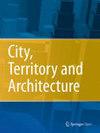Planning and meta-planning to cope with disruptive events: what can be learnt from the institutional response to the Covid-19 pandemic in Italy
Q1 Engineering
引用次数: 1
Abstract
Abstract The Covid-19 pandemic has been analysed and discussed from many disciplinary perspectives. An aspect that still needs critical exploration is the role—that is, the modes and forms—of regulatory interventions during the pandemic. It is interesting to note in this regard that, in many studies, regulatory measures are labelled “non-pharmaceutical interventions”, as if they do not have any specificity on their own and only represent a theoretically residual category. The main aim of this article is instead to focus on the distinctive features of normative measures as such. As regards the article’s focus, it centres on the normative interventions in the first period of the pandemic—that is, 2020—with particular reference to Italy. We have chosen to focus on this period because the most extensive and severe restrictions introduced to combat Covid-19 were established at that time. And we have chosen to consider Italy because it was the first country, after China, to be hard hit by the virus and to react in a draconian manner. As regards the methodology, the article is based, in general and primarily, on an extensive interdisciplinary literature review. With reference to the Italian case, the study is additionally based on: first-hand data collection and analysis (especially concerning Italian normative measures mainly issued at the national level: their type, frequency, target, hierarchical relationships); second-hand data and analysis (for instance as regards the effectiveness of Italy’s and other countries’ regulatory measures). In discussing the Italian response to the Covid-19 pandemic, certain weaknesses have been identified; and possible lessons have been highlighted, in terms of both “planning” (i.e. the necessity to better pre-define concrete and circumscribed sets of actions) and of “meta-planning” (i.e. the necessity of better planning the way in which public authorities could and should plan and act). Although this article is mainly based on the Italian situation, what we can learn from this case is largely generalizable.应对破坏性事件的规划和元规划:从意大利对Covid-19大流行的机构应对中学到什么
新冠肺炎大流行从多个学科角度进行了分析和讨论。仍然需要关键探索的一个方面是大流行期间监管干预的作用,即模式和形式。在这方面值得注意的是,在许多研究中,监管措施被标记为“非药物干预”,好像它们本身没有任何特异性,只代表理论上的剩余类别。相反,本文的主要目的是关注规范性措施本身的独特特征。关于该条的重点,它集中在大流行的第一阶段(即2020年)的规范性干预措施上,特别提到了意大利。我们选择把重点放在这一时期,因为为抗击Covid-19而采取的最广泛和最严格的限制是在这一时期制定的。我们选择考虑意大利,因为它是继中国之后第一个受到病毒严重打击并采取严厉应对措施的国家。至于方法论,文章是基于,总的来说,主要是基于广泛的跨学科文献综述。关于意大利的案例,该研究还基于:第一手数据收集和分析(特别是关于主要在国家一级发布的意大利规范性措施:其类型、频率、目标、等级关系);二手数据和分析(例如关于意大利和其他国家监管措施的有效性)。在讨论意大利应对Covid-19大流行的措施时,发现了某些弱点;在“规划”(即必须更好地预先确定具体和有限制的行动)和“元规划”(即必须更好地规划公共当局能够和应该规划和行动的方式)方面,可能的教训都得到了强调。虽然这篇文章主要是基于意大利的情况,但我们可以从这个案例中学到的东西在很大程度上是一般化的。
本文章由计算机程序翻译,如有差异,请以英文原文为准。
求助全文
约1分钟内获得全文
求助全文
来源期刊

City, Territory and Architecture
Engineering-Architecture
CiteScore
3.10
自引率
0.00%
发文量
36
审稿时长
13 weeks
 求助内容:
求助内容: 应助结果提醒方式:
应助结果提醒方式:


